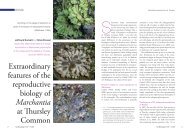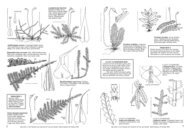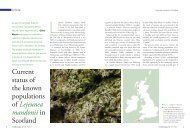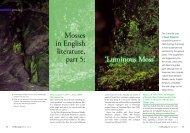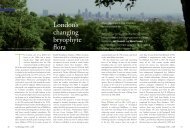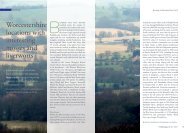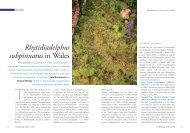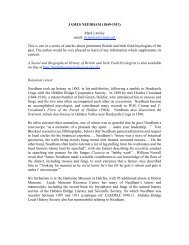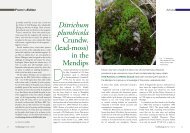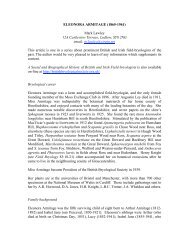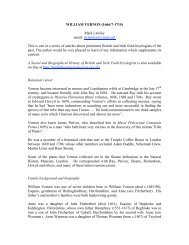The rediscovery and conservation status of Bazzania bhutanica in ...
The rediscovery and conservation status of Bazzania bhutanica in ...
The rediscovery and conservation status of Bazzania bhutanica in ...
Create successful ePaper yourself
Turn your PDF publications into a flip-book with our unique Google optimized e-Paper software.
BryophytesAbroad <strong>Bazzania</strong> <strong>bhutanica</strong> <strong>in</strong> Bhutan<br />
<strong>The</strong> <strong>rediscovery</strong><br />
<strong>and</strong> <strong>conservation</strong><br />
<strong>status</strong> <strong>of</strong> <strong>Bazzania</strong><br />
<strong>bhutanica</strong> <strong>in</strong><br />
Bhutan<br />
28 FieldBryology No101 | May10<br />
Prior to 2009, only<br />
one colony <strong>of</strong> <strong>Bazzania</strong><br />
<strong>bhutanica</strong> was known<br />
from Bhutan. However,<br />
dur<strong>in</strong>g an <strong>in</strong>vestigation<br />
last w<strong>in</strong>ter, a second<br />
colony was discovered.<br />
David G. Long,<br />
Baboo Ram Gurung<br />
<strong>and</strong> Rebecca Pradhan<br />
describe the story<br />
beh<strong>in</strong>d this species, its<br />
ecology <strong>and</strong> the threats<br />
to its existence.<br />
Bhutan is a small k<strong>in</strong>gdom <strong>in</strong> the east<br />
Himalayan Mounta<strong>in</strong>s s<strong>and</strong>wiched<br />
between India <strong>and</strong> Ch<strong>in</strong>a (Tibet),<br />
still relatively unexplored for<br />
bryophytes, but nevertheless known<br />
to have a rich bryophyte flora. Mizutani (1967)<br />
recorded six species <strong>of</strong> <strong>Bazzania</strong> from Bhutan,<br />
although three <strong>of</strong> these [B. tridens (Re<strong>in</strong>w. et al.)<br />
Trevis., B. himalayana (Mitt.) Schiffn. <strong>and</strong> B.<br />
sikkimensis (Steph.) Herz. were erroneous records<br />
orig<strong>in</strong>at<strong>in</strong>g from the Kalimpong district, West<br />
Bengal (former ‘British Bhutan’)]. His reports<br />
<strong>of</strong> B. imbricata (Mitt.) S.Hatt., B. griffithiana<br />
(Steph.) Mizutani <strong>and</strong> B. appendiculata (Mitt.)<br />
S.Hatt. were based on specimens collected by<br />
William Griffith <strong>in</strong> Bhutan <strong>in</strong> 1838.<br />
As a result <strong>of</strong> a number <strong>of</strong> botanical expeditions<br />
<strong>in</strong> the late 1970s <strong>and</strong> 1980s many bryophytes<br />
were collected by DGL. Study <strong>of</strong> the liverworts<br />
from these visits was led by the late Riclef Grolle<br />
<strong>and</strong> resulted <strong>in</strong> publication <strong>of</strong> a checklist (Long<br />
n Tongsa Dzong, one <strong>of</strong> the splendid religious fortresses<br />
<strong>of</strong> Bhutan. D. Long<br />
v B. <strong>bhutanica</strong> at one <strong>of</strong> its two known localities at<br />
Buduni near Samtse <strong>in</strong> south-west Bhutan, where it is<br />
critically endangered due to pressures <strong>of</strong> deforestation<br />
<strong>and</strong> development. D. Long<br />
& Grolle, 1990), which <strong>in</strong>creased the number<br />
<strong>of</strong> <strong>Bazzania</strong> species known from Bhutan to 14.<br />
Study <strong>of</strong> the mosses has progressed more slowly,<br />
but it is hoped to publish an updated moss<br />
checklist soon. Many new records for Bhutan<br />
<strong>and</strong> a few species new to science emerged from<br />
the liverwort collections; one <strong>of</strong> the latter was<br />
<strong>Bazzania</strong> <strong>bhutanica</strong>, discovered <strong>in</strong> 1982 <strong>and</strong><br />
published as a new species by Kitagawa & Grolle<br />
(1987).<br />
Dur<strong>in</strong>g a week at Samchi (now Samtse) <strong>in</strong><br />
south-west Bhutan, close to the Indian border, <strong>in</strong><br />
February/March 1982, a number <strong>of</strong> rav<strong>in</strong>es <strong>and</strong><br />
stream valleys lead<strong>in</strong>g down to the Indian pla<strong>in</strong>s<br />
were explored by A.J.C. Grierson <strong>and</strong> DGL, <strong>and</strong><br />
FieldBryology No101 | May10 29
<strong>Bazzania</strong> <strong>bhutanica</strong> <strong>in</strong> Bhutan<br />
n Above: Meteorium buchanani (Meteoriaceae), a common epiphyte <strong>in</strong> mossy temperate oak forests <strong>in</strong> Bhutan. D. Long<br />
x Centre: Wiesnerella denudata (Wiesnereallaceae), a rare, complex thalloid liverwort found along streams <strong>in</strong> humid<br />
temperate broadleaf forests <strong>in</strong> Bhutan. D. Long<br />
x Right: <strong>Bazzania</strong> tridens grow<strong>in</strong>g on shady rocks <strong>in</strong> the same rav<strong>in</strong>es where B. <strong>bhutanica</strong> was relocated. D. Long<br />
a few bryophytes were collected as well as many<br />
flower<strong>in</strong>g plants. It was <strong>in</strong> one <strong>of</strong> these rav<strong>in</strong>es<br />
that <strong>Bazzania</strong> <strong>bhutanica</strong> was discovered. <strong>The</strong>se<br />
foothills <strong>of</strong> the Bhutan Himalaya have <strong>in</strong> the<br />
past supported luxuriant subtropical forests<br />
(Grierson & Long, 1983) rich <strong>in</strong> large <strong>and</strong> <strong>of</strong>ten<br />
valuable trees such as Ailanthus gr<strong>and</strong>is, Bombax<br />
creiba, Pterospermum acerifolium, Shorea robusta,<br />
Term<strong>in</strong>alia myriocarpa <strong>and</strong> Tetrameles nudiflora,<br />
but over the past century <strong>in</strong>termittent logg<strong>in</strong>g<br />
has removed many <strong>of</strong> these trees <strong>and</strong> much <strong>of</strong><br />
the forest is now secondary. Nevertheless, along<br />
many streams <strong>in</strong> valleys <strong>and</strong> rav<strong>in</strong>es, reasonable<br />
forest cover has sometimes survived <strong>and</strong> such<br />
places are important refugia for trees, shrubs,<br />
lianas, herbs <strong>and</strong> bryophytes characteristic <strong>of</strong><br />
those forests. <strong>The</strong> primary human activities <strong>in</strong><br />
these forests are firewood <strong>and</strong> fodder harvest<strong>in</strong>g,<br />
<strong>and</strong> cattle graz<strong>in</strong>g, both <strong>of</strong> which are susta<strong>in</strong>able<br />
<strong>in</strong> moderation, but a significant threat to<br />
biodiversity if over-<strong>in</strong>dulged.<br />
<strong>The</strong> data given on the orig<strong>in</strong>al collection were:<br />
Bhutan, Samchi District, rav<strong>in</strong>e at Buduni<br />
W <strong>of</strong> Samchi, 26°54ʹN, 89°03ʹE, subtropical<br />
forest, on crumbl<strong>in</strong>g shady rock face, 380 m,<br />
1 March 1982, D.G. Long 10532 (E, KYO,<br />
NICH, JE).<br />
At the time <strong>of</strong> collection, its significance was<br />
not realized <strong>and</strong> no detailed records <strong>of</strong> ecology,<br />
population size, threats, etc., were made, though<br />
the bryophyte species Fissidens javanicus Dozy &<br />
Molk., Pallavic<strong>in</strong>ia lyellii (Hook.) Carruth. <strong>and</strong><br />
Solenostoma truncatum (Nees) R.M.Schust. ex<br />
Váňa & D.G.Long were collected <strong>in</strong> the same<br />
locality.<br />
A set <strong>of</strong> the 1982 liverworts was sent to Riclef<br />
Grolle <strong>in</strong> Jena, <strong>and</strong> his prelim<strong>in</strong>ary study <strong>of</strong><br />
Long 10532 led him to believe it might be a new<br />
species, <strong>and</strong> he therefore sent it to N. Kitagawa <strong>in</strong><br />
Nara, Japan, who confirmed its dist<strong>in</strong>ctness. This<br />
led to its description as a new species (Kitagawa<br />
& Grolle, 1987). <strong>The</strong>y noted that B. <strong>bhutanica</strong><br />
was very dist<strong>in</strong>ctive <strong>and</strong> different from all other<br />
known <strong>Bazzania</strong> species though it showed<br />
similarities to the related genus Acromastigum,<br />
but they regarded these as superficial <strong>and</strong> more<br />
important characters, such as branch<strong>in</strong>g pattern<br />
<strong>and</strong> stem anatomy, confirmed its placement <strong>in</strong><br />
<strong>Bazzania</strong> <strong>bhutanica</strong> <strong>in</strong> Bhutan<br />
<strong>Bazzania</strong>. S<strong>in</strong>ce that study, Meagher (2006) has<br />
described a new species, <strong>Bazzania</strong> scalaris, from<br />
Papua New Gu<strong>in</strong>ea, <strong>and</strong> suggested that its closest<br />
relative is B. <strong>bhutanica</strong>, though this differs from<br />
B. scalaris <strong>in</strong> that ‘the cuticle [<strong>of</strong> B. <strong>bhutanica</strong>] is<br />
strongly asperous <strong>and</strong> <strong>of</strong>ten coarsely verruculose, the<br />
cells <strong>of</strong> the lateral leaves have evenly thickened walls<br />
<strong>and</strong> <strong>in</strong>dist<strong>in</strong>ct trigones, <strong>and</strong> the lobes <strong>of</strong> the lateral<br />
leaves are only weakly spread<strong>in</strong>g’ <strong>and</strong> ‘ the leaves are<br />
much shorter <strong>and</strong> more or less contiguous to slightly<br />
imbricate’. To date B. scalaris is the only known<br />
close relative <strong>of</strong> B. <strong>bhutanica</strong>.<br />
Over recent decades the ‘Bryophyte<br />
Specialist Group’ <strong>of</strong> the IUCN Species Survival<br />
Commission has been compil<strong>in</strong>g a global ‘Red<br />
List’ <strong>of</strong> bryophytes (Anonymous 2009), <strong>and</strong><br />
follow<strong>in</strong>g discussions with DGL, four liverworts<br />
from Bhutan were <strong>in</strong>cluded on that list along<br />
with an evaluation <strong>of</strong> their <strong>conservation</strong> <strong>status</strong>:<br />
Andrewsianthus ferrug<strong>in</strong>eus Grolle (Endangered),<br />
B. <strong>bhutanica</strong> (Critically Endangered), Scaphophyllum<br />
speciosum (Horik.) H.Inoue (Vulnerable)<br />
<strong>and</strong> Schistochila macrodonta W.E.<br />
Nicholson (Endangered). <strong>The</strong> ‘CR’ <strong>status</strong><br />
accorded to B. <strong>bhutanica</strong> was due to the view that<br />
it was considered to be fac<strong>in</strong>g an extremely high<br />
v Mossy temperate mixed conifer/broadleaf forests on<br />
the Dochu La, east <strong>of</strong> the capital, Thimphu. D. Long<br />
30 FieldBryology No101 | May10 FieldBryology No101 | May10 31
<strong>Bazzania</strong> <strong>bhutanica</strong> <strong>in</strong> Bhutan<br />
risk <strong>of</strong> ext<strong>in</strong>ction <strong>in</strong> the wild <strong>in</strong> the immediate<br />
future because <strong>of</strong> its ‘occurrence estimated to be<br />
less than 100 km 2 , area <strong>of</strong> occupancy estimated to<br />
be less than 10 km 2 ’ <strong>and</strong> ‘known to exist at only a<br />
s<strong>in</strong>gle location’.<br />
As B. <strong>bhutanica</strong> had not been seen <strong>in</strong> the<br />
wild for 27 years, it was considered urgent<br />
<strong>and</strong> important that an attempt be made to ref<strong>in</strong>d<br />
the plant <strong>and</strong> clarify its current <strong>status</strong>.<br />
WWF awarded a small grant <strong>in</strong> 2009 to BRG<br />
to undertake this <strong>in</strong>vestigation <strong>and</strong> through RP<br />
an approach was made to DGL to assist with a<br />
new survey. DGL was able to visit Bhutan for<br />
3 weeks <strong>in</strong> November/December 2009 <strong>and</strong> all<br />
three <strong>of</strong> us undertook 2 days <strong>of</strong> field work at<br />
Samtse to carry out a search for B. <strong>bhutanica</strong>.<br />
On 6 December 2009 we relocated the plant <strong>in</strong><br />
the orig<strong>in</strong>al locality at Buduni <strong>and</strong> also <strong>in</strong> a new<br />
locality nearby at Lafeti Khola, <strong>and</strong> were able<br />
to collect small voucher samples, record more<br />
detailed ecological data, reassess the threats <strong>and</strong><br />
take digital images <strong>of</strong> the plant <strong>and</strong> its habitat.<br />
<strong>The</strong> details <strong>of</strong> these collections are as follows:<br />
32 FieldBryology No101 | May10<br />
Bhutan, Samtse District, Buduni Kholsa<br />
rav<strong>in</strong>e west <strong>of</strong> Samtse, 26°54ʹ26.8ʹʹN,<br />
89°04ʹ05.8ʹʹE, 295 m, steep-sided valley <strong>in</strong><br />
degraded subtropical forest, on soil <strong>in</strong> exposed<br />
vertical face <strong>of</strong> river terrace by stream, 6 Dec<br />
2009, Long, Pradhan & Gurung 38845<br />
(THIMPHU, E); Lafeti Khola valley west<br />
<strong>of</strong> Samtse, 26°54ʹ27.3ʹʹN, 89°03ʹ52.1ʹʹE,<br />
296 m, steep-sided valley <strong>in</strong> degraded<br />
subtropical forest, on vertical river terrace face<br />
by stream, 6 Dec 2009, Long, Pradhan &<br />
Gurung 38854 (THIMPHU, E).<br />
<strong>The</strong> two localities are ecologically almost<br />
identical, <strong>in</strong> stream valleys <strong>in</strong> degraded subtropical<br />
forest, with trees such as Castanopsis <strong>in</strong>dica,<br />
Chisocheton cum<strong>in</strong>gianus, Duabanga gr<strong>and</strong>iflora,<br />
Lithocarpus fenestratus, Litsea salicifolia,<br />
P<strong>and</strong>anus furcatus <strong>and</strong> Tetrameles nudiflora,<br />
shrubs <strong>in</strong>clud<strong>in</strong>g Boehmeria macrophylla,<br />
Callicarpa arborea, Hyptianthera stricta, Piper<br />
sp. <strong>and</strong> Wendl<strong>and</strong>ia gr<strong>and</strong>is, climbers such as<br />
Calamus latifolius, Glycosmis cymosa, Lepisanthes<br />
senegalensis, Mikania micrantha, Rhaphidophora<br />
v <strong>The</strong> subtropical<br />
foothills <strong>of</strong> south-<br />
west Bhutan near<br />
Samtse show<strong>in</strong>g one<br />
<strong>of</strong> the many small<br />
stream valleys<br />
descend<strong>in</strong>g to the<br />
pla<strong>in</strong>s on the Indian<br />
border. D. Long<br />
hookeri <strong>and</strong> Pothos sc<strong>and</strong>ens, <strong>and</strong> the large ferns<br />
Angiopteris sp. <strong>and</strong> Cyathea sp<strong>in</strong>ulosa. <strong>The</strong> B.<br />
<strong>bhutanica</strong> plants formed yellow-green mats<br />
closely appressed to a vertical, gravelly, northwest-fac<strong>in</strong>g<br />
bank (an eroded ancient river<br />
terrace), <strong>in</strong> the Buduni rav<strong>in</strong>e with about 50%<br />
cover <strong>in</strong> an area <strong>of</strong> approximately 5 × 1 m, closely<br />
associated with a Hymenophyllum species <strong>and</strong> the<br />
bryophytes Pallavic<strong>in</strong>ia lyellii, Fissidens sp. <strong>and</strong><br />
<strong>Bazzania</strong> tridens (Re<strong>in</strong>w. et al.) Trevis., which<br />
was more bluish-green than B. <strong>bhutanica</strong>. In<br />
the Lafeti site B. <strong>bhutanica</strong> was more abundant<br />
than at Buduni, occupy<strong>in</strong>g 30–40% cover on<br />
a vertical bank <strong>of</strong> approximately 10 × 2 m. <strong>The</strong><br />
associated bryophytes were as at Buduni, though<br />
Hymenophyllum was absent. In both sites, the<br />
colonies were heavily shaded by overhang<strong>in</strong>g<br />
shrubs.<br />
In terms <strong>of</strong> <strong>conservation</strong>, both sites are<br />
highly vulnerable to immediate <strong>and</strong> future<br />
threats. Immediate threats are any <strong>in</strong>crease<br />
<strong>in</strong> forest clearance by villagers for firewood<br />
<strong>and</strong> fodder for livestock, <strong>and</strong> over-graz<strong>in</strong>g by<br />
cattle, both <strong>of</strong> which will cause further loss <strong>of</strong><br />
tree <strong>and</strong> shrub cover, <strong>and</strong> therefore destroy<br />
the shade <strong>and</strong> humidity vital to the survival <strong>of</strong><br />
B. <strong>bhutanica</strong>. Longer-term threats appear to<br />
be severe: a new National Development Plan<br />
under preparation <strong>in</strong> Bhutan is likely to <strong>in</strong>clude<br />
Samtse <strong>and</strong> its surround<strong>in</strong>g area as a zone for<br />
<strong>in</strong>dustrial <strong>and</strong> hous<strong>in</strong>g development (on account<br />
<strong>of</strong> its proximity to India), <strong>and</strong> both sites for<br />
B. <strong>bhutanica</strong> are likely to be destroyed if this<br />
development goes ahead. Even if the immediate<br />
sites were protected, nearby development would<br />
probably lead to abstraction <strong>of</strong> the water supplies<br />
from these valleys <strong>and</strong> the greatly <strong>in</strong>creased<br />
human population would add to degradation<br />
<strong>and</strong> possibly over-graz<strong>in</strong>g <strong>of</strong> these localities.<br />
Our conclusion is that, <strong>in</strong> spite <strong>of</strong> the discovery<br />
<strong>of</strong> a second population <strong>of</strong> B. <strong>bhutanica</strong>, its <strong>status</strong><br />
<strong>Bazzania</strong> <strong>bhutanica</strong> <strong>in</strong> Bhutan<br />
at Samtse as Critically Endangered is fully<br />
justified <strong>and</strong> should be ma<strong>in</strong>ta<strong>in</strong>ed. We strongly<br />
recommend that a search for further colonies <strong>in</strong><br />
other parts <strong>of</strong> southern Bhutan be undertaken as<br />
soon as possible, <strong>and</strong> recommend to the Royal<br />
Government <strong>of</strong> Bhutan that future <strong>in</strong>dustrial<br />
development be zoned <strong>in</strong> a more appropriate<br />
area.<br />
David G. Long 1 , Baboo Ram Gurung 2 <strong>and</strong><br />
Rebecca Pradhan 3<br />
1 Royal Botanic Garden, 20A Inverleith Row,<br />
Ed<strong>in</strong>burgh EH3 5LR (e d.long@rbge.ac.uk);<br />
2 c/o Mani Kala Laygoi, Royal Institute <strong>of</strong> Health<br />
Sciences, Thimphu, Bhutan; 3 Royal Society for<br />
Protection <strong>of</strong> Nature, Thimphu, Bhutan.<br />
Acknowledgments<br />
We thank the National Biodiversity Centre <strong>of</strong> the M<strong>in</strong>istry <strong>of</strong><br />
Agriculture, Serbithang, Thimphu, Bhutan <strong>and</strong> the M<strong>in</strong>ister <strong>of</strong><br />
Agriculture Lyonpo Dr Pema Gyamtsho, Royal Government<br />
<strong>of</strong> Bhutan, for support for botanical work <strong>in</strong> Bhutan, <strong>and</strong> the<br />
WWF for support<strong>in</strong>g survey work on B. <strong>bhutanica</strong>. T<strong>and</strong><strong>in</strong><br />
Wangdi, Tsher<strong>in</strong>g Dorji, Dechen Lham, Karma Wangchuck,<br />
Ral<strong>in</strong>g Nawang Drukda, Sonam Tsher<strong>in</strong>g <strong>and</strong> Mani Raj Rai are<br />
thanked for help with the 2009 field trip <strong>in</strong> Bhutan.<br />
References<br />
Anonymous (2009). IUCN Red List <strong>of</strong> Threatened Species.<br />
Version 2009.2. http://www.redlist.org/<br />
Grierson, A.J.C. & Long, D.G. (1983). Flora <strong>of</strong> Bhutan.<br />
Volume 1, Part 1. Ed<strong>in</strong>burgh: Royal Botanic Garden<br />
Ed<strong>in</strong>burgh.<br />
Kitagawa, N. & Grolle, R. (1987). A new Acromastigum-like<br />
species <strong>of</strong> <strong>Bazzania</strong> S. Gray from Bhutan. Journal <strong>of</strong> the<br />
Hattori Botanical Laboratory 61, 269–272.<br />
Long, D.G. & Grolle, R. (1990). Hepaticae <strong>of</strong> Bhutan II.<br />
Journal <strong>of</strong> the Hattori Botanical Laboratory 68, 381–440.<br />
Meagher, D. (2006). <strong>Bazzania</strong> scalaris sp. nov.<br />
(Marchantiophyta: Lepidoziaceae) from Papua New Gu<strong>in</strong>ea.<br />
Telopea 11, 246–251.<br />
Mizutani, M. (1967). Studies <strong>of</strong> the Himalayan species <strong>of</strong><br />
<strong>Bazzania</strong>. Journal <strong>of</strong> the Hattori Botanical Laboratory 30,<br />
71–90.<br />
FieldBryology No101 | May10 33



